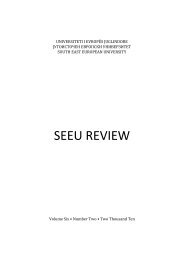SEEU Review vol. 5 Nr. 2 (pdf) - South East European University
SEEU Review vol. 5 Nr. 2 (pdf) - South East European University
SEEU Review vol. 5 Nr. 2 (pdf) - South East European University
You also want an ePaper? Increase the reach of your titles
YUMPU automatically turns print PDFs into web optimized ePapers that Google loves.
<strong>SEEU</strong> <strong>Review</strong> Volume 5, No. 2, 2009<br />
Luca Papi (2005) tried to define different aspects of the central bank<br />
independence. He defined the political independence as the possibility of<br />
central bank to fulfill independently from the political authorities the<br />
delegated objectives 2 . The main elements of political independence are the<br />
institutional 3 , objectives 4 and instruments independence 5 . Instruments<br />
independence is made up of two components: operational independence 6<br />
and financial independence 7 .<br />
The last kind of independence is related to the operational independence<br />
are: regulative independence 8 and surveillance independence 9<br />
Independence of <strong>South</strong> <strong>East</strong>ern Europe central banks and<br />
<strong>European</strong> integration<br />
Central Bank independence is especially important for the countries that<br />
want to access the <strong>European</strong> Union and the <strong>European</strong> Monetary Union<br />
because they have to meet certain criteria that guarantee the independence of<br />
their central banks.<br />
Preconditions for <strong>European</strong> Monetary Union integration are: functional<br />
independence of central bank, institutional independence of central bank,<br />
personal independence, financial independence, independence in the central<br />
bank budget preparation, and the non – financing of the state budget. Further<br />
adoptions, according to Article 109 of Maastricht Tractate for total legal<br />
integration in Euro system, deal with the adjustment of monetary policy<br />
instruments, with foreign currency reserves management and preservation,<br />
etc.<br />
The main objectives of <strong>South</strong> <strong>East</strong>ern Europe central banks generally<br />
match the Maastricht criteria; the main objective of most of the central banks<br />
is price stability. So we can say that most of the central banks have achieved<br />
the functional independence.<br />
2<br />
3<br />
4<br />
5<br />
6<br />
7<br />
8<br />
9<br />
Papi referred to both vertical and horizontal aspects of delegated attributes.<br />
Bakas gave the same definition as Papi for this type of independence<br />
Central bank is the authority that determines its own priorities through the selection of the objectives.<br />
This definition is closely related with the concept of operational independence<br />
This is the first rule of Basic Principles of the Committee of Bazel for an effective banking supervision<br />
Bakas gave the same definition as Papi for this type of independence<br />
It defines the possibility to draw regulation and procedures for the financial sector.<br />
This type of independence guarantees the sustainability and stability of financial sector. It includes leasing,<br />
regulative supervision, licensing and revocation of licenses, and crises administration<br />
55

















